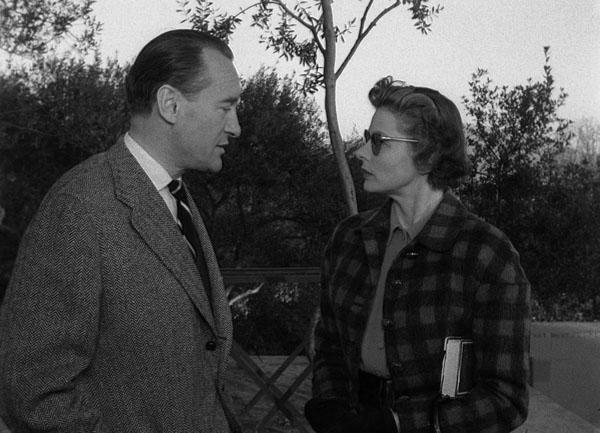“As auteurist demigods go, Roberto Rossellini is still tough to nail down,” begins Michael Atkinson in the Voice: “there’s the neorealist Rossellini, the wrestling-adulterously-with-Ingrid-Bergman Rossellini, the kicked-out-of-India Rossellini, and the low-budget TV-historian Rossellini. Each has had his moment in the sun, but today the light falls on the Bergman years, and particularly on this melancholic 1954 heartbreaker, now recognized as a career-defining masterpiece. Inescapably, it’s a film about the fragility of marriage (Ingrid and Roberto had only been married for four years at this point, and wouldn’t last another four), in which a British couple (Bergman and George Sanders) descend on Naples to sell an inherited house.”
“Already bored by the time they reach a property they’re selling, the troubled couple allow differences in taste and temperament to drive them towards divorce,” writes BFI programmer Geoff Andrew, introducing the trailer for the new restoration of Voyage to Italy by Cineteca di Bologna, opening today at Film Forum in New York, screening at LACMA on May 9, and then beginning a run in London and Edinburgh on May 10.
“Rossellini captured his wife and muse in a light completely different from her glamorous Hollywood persona,” notes Fernando F. Croce in Slant. “Drawn, fretful, and confused, the Swedish star wanders through these films as if looking anxiously at the man behind the camera, begging for direction while the exploratory Rossellini sought emotional truth by dropping her into alien landscapes. It’s a harrowing series of portrayals of unsettled female consciousness, and also a glimpse into a complex behind-the-scenes romance as revealing as the films Josef von Sternberg made with Marlene Dietrich some 20 years earlier. If not quite their The Devil Is a Woman, the 1954 masterpiece Voyage to Italy is similarly awash in the emotional unease of a relationship racing to its end, a meta sketchbook where the disillusionment of the protagonists seems to irresistibly mirror that of the actress and the filmmaker. That out all of this emerges one of cinema’s most transcendently hopeful works is the kind of contradiction surely appreciated by Rossellini, an analytical yet emotive visionary who could film miracles as if they were part of the everyday fabric of life.”
“Voyage is not driven by the usual machinery of plot and exposition, but rather by a succession of moods, an emotional logic alternately reflected and obscured by the picturesque surroundings,” writes A.O. Scott in the New York Times. “The rich symbolism of the Italian landscape—the volcanic pools at Vesuvius, the ruins of Pompeii, the vistas that have stirred the imagination of artists at least since Virgil—makes the emptiness of the Joyces’ marriage all the more palpable and painful…. Rossellini’s way of dissolving narrative into atmosphere, of locating drama in the unspoken inner lives of his characters, anticipates some of what Michelangelo Antonioni would do a few years later in L’Avventura. Voyage to Italy is thus in the vanguard of what Pauline Kael would disparagingly call ‘come-dressed-as-the-sick-soul-of-Europe parties.’ Some of us will never tire of those soirees, with their black-tied gloom and elegant suffering, and will therefore relish the beauty and melancholy of this voyage, along with its touristic snapshots and heart-tugging Neapolitan songs.”
Introducing the video below at the New Yorker in January 2012, Richard Brody wrote: “The critics who were most enthusiastic about what [Rossellini] was doing were the young ones at Cahiers du Cinéma, the future French New Wave; Jean-Luc Godard said that Voyage to Italy taught him that he could make a classic-style film on a low budget with just ‘a man, a woman, and a car’; and Rossellini quickly returned the favor: in the mid-fifties, he sought to organize a series of low-budget productions that these critics would themselves write and direct. The project came to nought. Bergman and Rossellini divorced, and she returned to the Hollywood fold; but the connection between them and the New Wave—and the modern cinema as such—remains unbroken.”
“The French critics flipped for it (as did Martin Scorsese),” writes Joshua Rothkopf in Time Out New York, “but a younger, curious generation will be able to see Lost in Translation and Mad Men in here, which is all by way of saying that Voyage to Italy is the kind of movie that makes those unhappily in love feel understood. And even if that’s not you (congratulations), it’s still possible to groove on Rossellini’s stranger-in-a-strange-land psychodrama.”
Update, 5/6: “Barely scripted (much to Sanders’s annoyance), the movie was shot in a half-planned, half-improvisatory manner, and Rossellini infuriated everyone, Bergman included, by refusing to shoot for days on end when inspiration was absent.” John Patterson in the Guardian: “Patience paid off, however, and Rossellini created a film whose poetry is fathomless and wondrous, melancholy and wise.”
Update, 5/10: The Guardian‘s Peter Bradshaw hails Voyage as “cine-ancestor to Antonioni‘s L’Avventura and Roeg’s Don’t Look Now.”
For news and tips throughout the day every day, follow @KeyframeDaily on Twitter and/or the RSS feed. Get Keyframe Daily in your inbox by signing in at fandor.com/daily.




